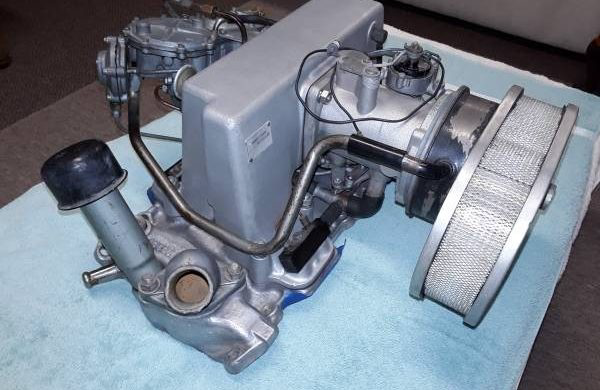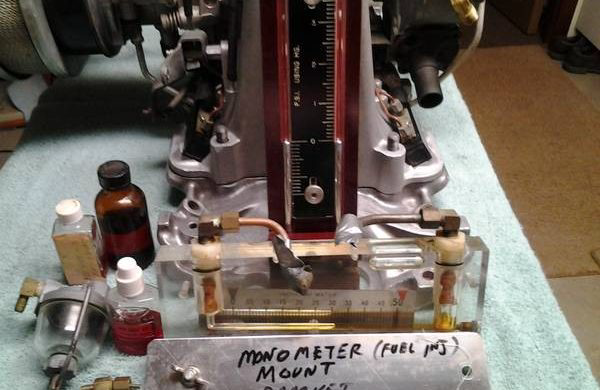Fuel injection has been around in various forms since the early 1900’s, but wasn’t widely used in the United States until the 1980’s. Fuel injection has replaced carburetion on almost every modern vehicle including in NASCAR. The ability to inject fuel directly into the intake (or cylinders) of an engine dramatically increases efficiency and often increases power. This Corvette Rochester fuel injection system can be found here on Craigslist with an asking price of $9,500! The system is located in Bath, Pennsylvania and supposedly ran on the seller’s 327 c.i.d. engine for about 20 years with no problems. Thanks to Barn Finds reader Levi Andrus for the tip on this intake.

In 2003, Super Chevy Magazine ran a series of articles on these fuel injection systems. If you are interested in the details regarding building, installing and maintaining them, check out the link here. The articles are really detailed and should give you all the information you need to get started. The illustration above shows the basic operation of the system. Air is forced into the intake where fuel is injected directly into the runners. Pretty basic technology compared to todays computer-controlled EFI, but still ahead of its time for the 1960’s.
Rochester Products Division (or RPD) was a division of General Motors that was based in Rochester, New York. RPD is best known for developing the Quadrajet carburetor. They also developed fuel injection systems that were featured on Chevrolet vehicles starting in 1957. The option was reportedly less than $500! Can you imagine telling someone in 1960 that the intake on their new Corvette would be worth almost $10,000 in 60 years?
Here is a close-up of some of the included accessories with this injection system. The monometer gauge is for adjusting and setting the lean and rich stops. You can also see the clear glass bowl that shows the fuel as it goes into the engine. Certainly some nostalgia that is lost on modern vehicles. What do you think? Is this system worth nearly five figures? Supply and demand drives prices and something’s worth what someone is willing to pay for it. I guess time will tell if it sells…



it was available in the 50s
1957. Available on Chevy cars.
They’re nuts. If I remember, these were a lot of problems, like cold start especially. Didn’t many owners take these off and run just a 4 barrel? ( which is maybe why it’s here)
These are really great units, even today. You do have to understand hew they work, which is rally simple.
Great for a trailer queen, I’d use a carb.
$500 was about $4500 in 1950’s money. One reason it wasn’t a popular option.
Yes these FI units from GM had problems.
But I remember when these were new and optioned on some GM cars. They were the holy grail for performance fans at one time, and you knew the car’s owner was a performance freak if he shelled out for the FI option on his car.
As I understand it, a big problem with these FI units was that they ran very low fuel pressure compared to other, more successful FI systems. That low pressure made it hard for the GM units to run consistently. They were also difficult to tune—and you had to tune them. Not like today’s FI.
I remember driving a ’62 Corvette with FI one time back in the day. The car was way down on power and ran badly. I also remember riding in the same car another time with the owner driving. The car had recently been tuned at a Chevy dealer and ran very strong, probably the fastest car I had ever been in up to that point.
If you look at the bunch of tuning stuff that comes with this FI unit, you can see what the seller had to do to get the unit to run properlyl. This FI unit may be cool for a GM car owner, but it is like night and day compared to the current, mostly foolproof FI systems we have on cars today.
Just one more example ( as if we need anymore) why the old car hobby is out of reach for most of us. Ok, I’ll admit, the FI unit was a highly touted option, and probably most of it’s attraction was, most of us had no idea what it was. It took another 30 years before FI finally replaced the carburetor. So, seeing what they want for this, is it justifiable for someone redoing a Corvette, to plunk down $10g’s, for something that may make it run poorly, just for the sake of originality? Apparently these auctions today are trying to convince us that’s so.
Howard A. Funny, I never remember the old car hobby being cheap. Difference today is way to many winers on the internet!
In the late 1960s, the early FI units, complete with all the goodies, were practically giveaways. One could pick them up for a few bucks (as in less than than $50, in SoCal).
As Dolphin noted, when they ran well, they ran very well, but more often than not, they didn’t, hence why so many were replaced with carbs. They could be tuned, but were a PITA compared to the average four-barrel.
They were a headache in their day, which is why they were retrofitted with carbs and thrown in the junk pile, which is why they’re rare today, which is why they cost more than many good used Corvettes.
Really?
There was nothing wrong with the early Chevrolet fuel injection units. People who claim otherwise, have never owned one, or don’t know enough about them. For the time, it was a great system. It produced more horse power than any contemporary carb, and got much better gas mileage too.
If there was a problem with them, it was that people didn’t know how to work on them. Today every car is fuel injected, but back then it was very rare, and most mechanics had never seen one, let alone worked on one. Finding a mechanic in 63, who knew how to work on an FI unit, is like trying to find one today, who can rebuild a carb.
The 57 FI produced 283 horse power, from a 283 cubic inch engine, making it the first engine ever to produce one horse power per cubic inch. This was big news in 57, and every new Corvette buyer wanted fuel injection, but not many could afford an extra $484, on top of the $3300 Corvette base price.
Chevrolet offered the FI on Corvettes for 9 years, and found 12000 buyers willing to pay anywhere from $480-$726 (the price of the 57 “air box” system) to buy it. Chevrolet only dropped FI in 1965, after they introduced the 396. In the 60’s, cubic inches were king, and the 396 produced 50 more horse power, and cost half as much money.
I’m not sure what the monometer’s worth, but an unrestored 60-62 fuel unit, with the correct distributor, is probably worth around $6000, not $9500.
Well said!
I was young once. I always wanted to see a FI Corvette. Then I saw a fairly attractive girl on the side of I-70 with the hood up on her Vette. Sure enough it was a FI model. I stopped to see if I could help her. About the same time, a trucker about 3 times my size stopped and said “take off kid”. I took off. But I did get to see under the hood first.
Had a good friend in ’70’s who worked at RPD as a boss. Said there were enough fuelie parts still in stock he would build me a fuel injection if I wanted. Never took him up on it. Probably should have but that’s life I guess.
I had a metal shop teacher that used to build and tune these units. He would have a least 2 on the bench in our auto shop class. He was a very talented guy and knew more than the auto shop teacher.
The very first unit was more problematic. By the time this one was made, they worked well. I would recommend knowing someone like Chuck Smith, then you are OK. Would be a neat unit on a 327 with 461 heads and forget about the number matching.